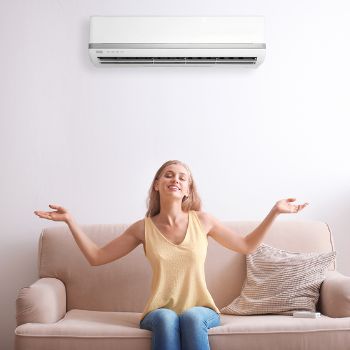How Your Air Conditioner’s Fan Setting Works
 Your home’s air conditioning unit or HVAC system is equipped with multiple buttons related to output and comfort level. Beyond the self-explanatory “cool” and “heat” settings, the fan mode can be more of a mystery to homeowners.
Your home’s air conditioning unit or HVAC system is equipped with multiple buttons related to output and comfort level. Beyond the self-explanatory “cool” and “heat” settings, the fan mode can be more of a mystery to homeowners.
Fan mode offers a more energy-efficient cooling solution to extend the effects of the cool setting. Understand what the fan does and how you should be using this feature.
What Is A/C Fan Mode?
“Fan” activates the unit’s blower to circulate air produced in your home but does not turn on the compressor. Unlike a window fan, it won’t circulate air from the outdoors and unlike cool mode, it won’t generate new colder air.
When you turn on fan mode, you may start to feel a breeze. The home’s interior temperature will not drop, but the air will likely feel less stagnant. After you’ve run the air conditioner on cool, switching to fan mode helps better distribute the cold air through your home, while using less power.
If you’re using a central air conditioning system, fan mode is connected to the furnace. As it moves air around your home, the fan diverts warm air to the condenser with help from the indoor air handler. However, the condenser won’t cool it. The air travels to the furnace, where it’s divided among the ducts traveling throughout your home. You’ll then feel air emerge through the vents.
On the other hand, fan mode for a window unit will circulate air throughout the room, no matter its temperature.
Why You Should Use Fan Mode
When you’re looking to efficiently cool your home, fan mode offers the following benefits:
- Cool air travels farther within the ducts without having to use the AC’s full power
- Air circulation can help manage allergies and control indoor air pollution
- Fan mode helps your home achieve a more consistent temperature sooner
- Since the compressor is not working, the air conditioning unit uses less power
How to Use Fan Mode
Fan mode does not function like a ceiling fan or act as a dehumidifier. Instead, its recommended to switch the air conditioner to fan mode after your home is feeling partially cool to better distribute the air. However, keep the following in mind:
- Fan mode won’t be effective when your home is humid.
- Fan mode still requires clean filters. Ignoring routine maintenance can cause dirty air to circulate through your home.
- Fans are not designed to substitute cool mode and should be used sparingly. Otherwise, long-term use can cause your home’s indoor temperature and humidity to rise. The thermostat then senses a higher temperature and has to work harder the next time.
It’s also important to become familiar with the system controls. “Auto” and “On” buttons control the blower fan:
- Auto means the fan only turns on when the air conditioning unit is cooling the home’s air. “On” keeps the fan going at a consistent speed, no matter the A/C unit’s operation.
- It’s generally recommended to keep the fan on Auto. “On” is ideal for whole-house cooling after you’ve run the cool setting.
- Using “On” for an extended period can place wear on the system, particularly the blower fan, and will consume more energy. By contrast, Auto can help control energy usage.
- Auto lets moisture from your home evaporate between cooling cycles.
- As Auto operation is periodic, the A/C unit generates less noise in your home. Higher-efficiency systems further reduce the amount of noise.
- The consistent operation of “On” can help remove particles from the air.
Are you noticing more humidity or noise in your home when you operate the air conditioner, no matter the setting? Contact the technicians at MJ Fahy & Sons to inspect your air conditioning system today.




